Affiliate links on Android Authority may earn us a commission. Learn more.
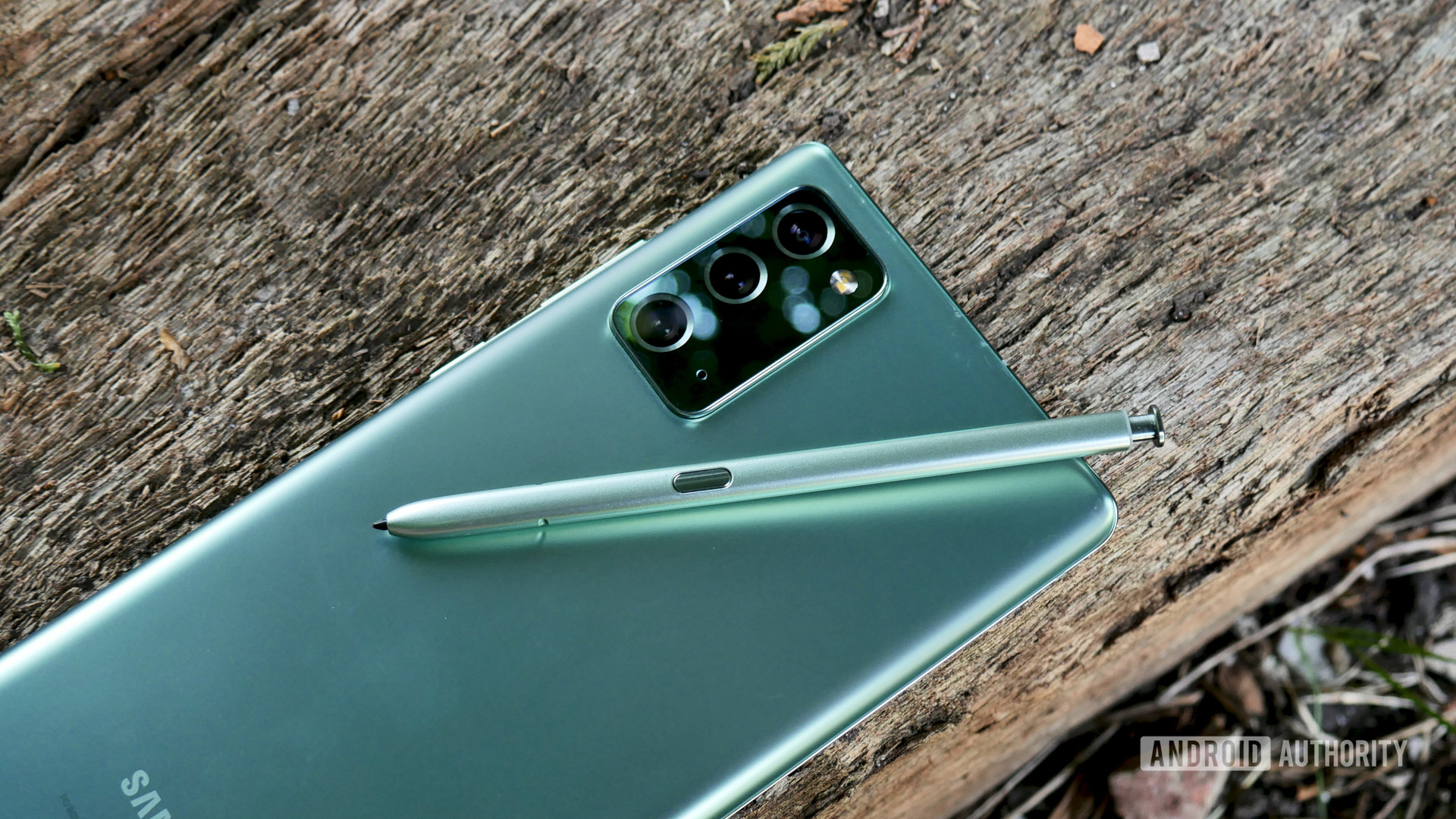
Samsung Galaxy Note 20
MSRP:
What we like
What we don't like
Our scores
Samsung Galaxy Note 20
Samsung’s premium smartphone strategy is in flux. Between its ever-expanding foldable phone portfolio and obscenely spec’d devices under the “Ultra” branding, it’s easy to forget about the Galaxy Note family and in particular 2020’s standard Note model — the Galaxy Note 20.
2019 marked the first year where Samsung offered two Note series phones at the same time. Rather than settle into a pattern, the South Korean giant switched things up again in 2020. The Note 20 Ultra — a monstrous phone with a monstrous price tag — usurped the short-lived Note “Plus” line. But where does that leave the non-Ultra model, the Galaxy Note 20, especially after Samsung skipped the Note line entirely in 2021?
The Galaxy Note 10 changed the identity of the vanilla Note lineage, offering what some considered to be a watered-down take on the Note formula. However, if the Note 10 was a confusing smartphone, the Galaxy Note 20 remains an outright confounding one.
This is Android Authority’s Samsung Galaxy Note 20 review.
Design: Pain in the glass
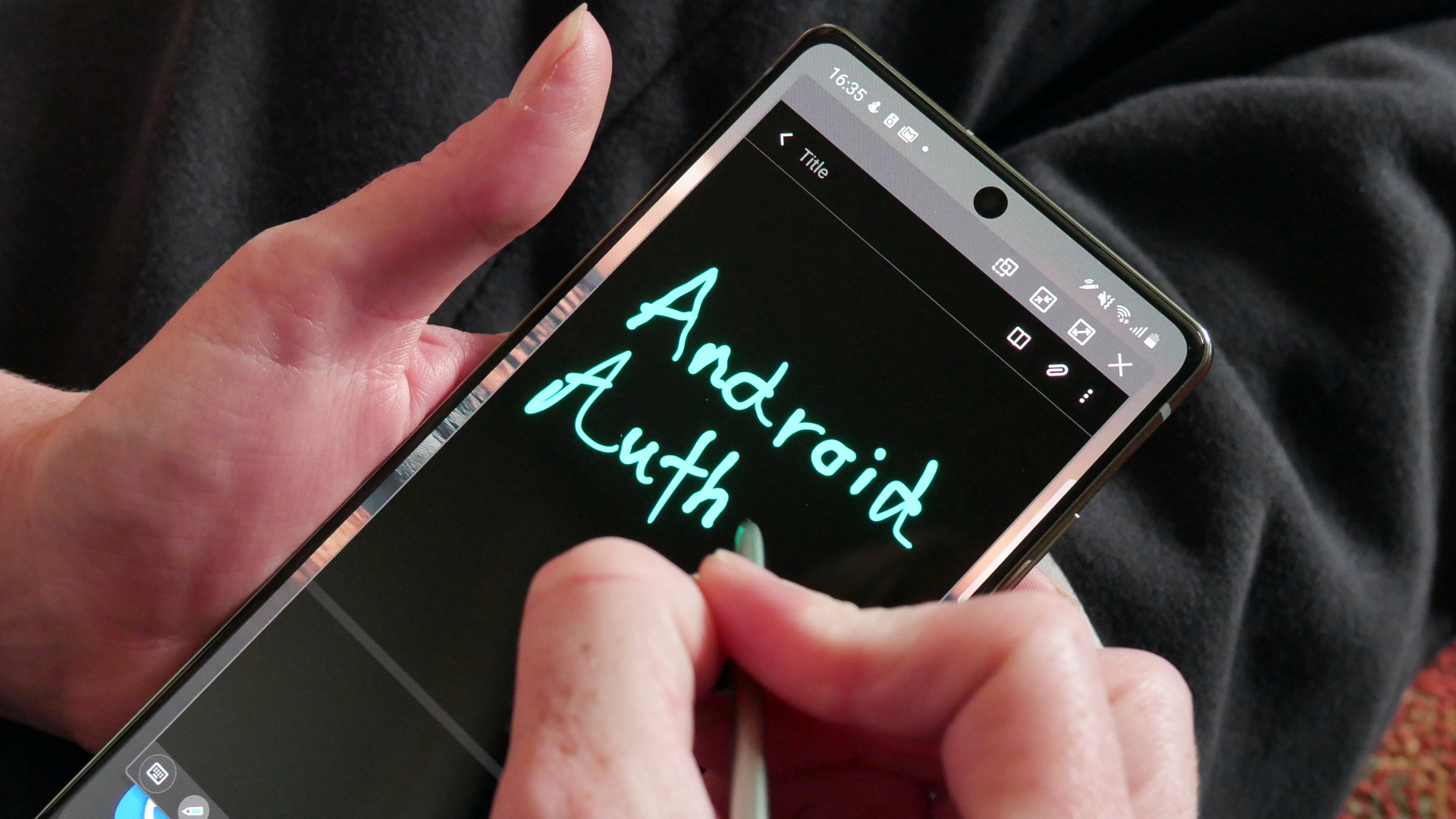
- Gorilla Glass 5 (front), plastic (rear)
- IP68 certified
- 161.6 x 75.2 x 8.3mm
- 192g
Face on, the Galaxy Note 20 looks unmistakably like a Galaxy Note phone. Instead of continuing the Note 10’s shrunken take on Samsung’s phablet formula, the Note 20 is a big boi.
See also: Samsung Galaxy Note series — A history of innovation
It also sports the Note series’ rectangular-style and, of course, a pop-out S Pen stylus. The front glass melds effortlessly into the metal frame, the hardware buttons — a standard power key and volume rocker — are firm yet tactile, and every time you remove or dock the S Pen there’s a subtle vibration which is a nice reminder of the phone’s perfectly measured haptics.
The Galaxy Note 20 oozes the kind of finesse and delicate attention to detail that you’d expect from the world’s most successful smartphone maker. And then you turn the phone around…
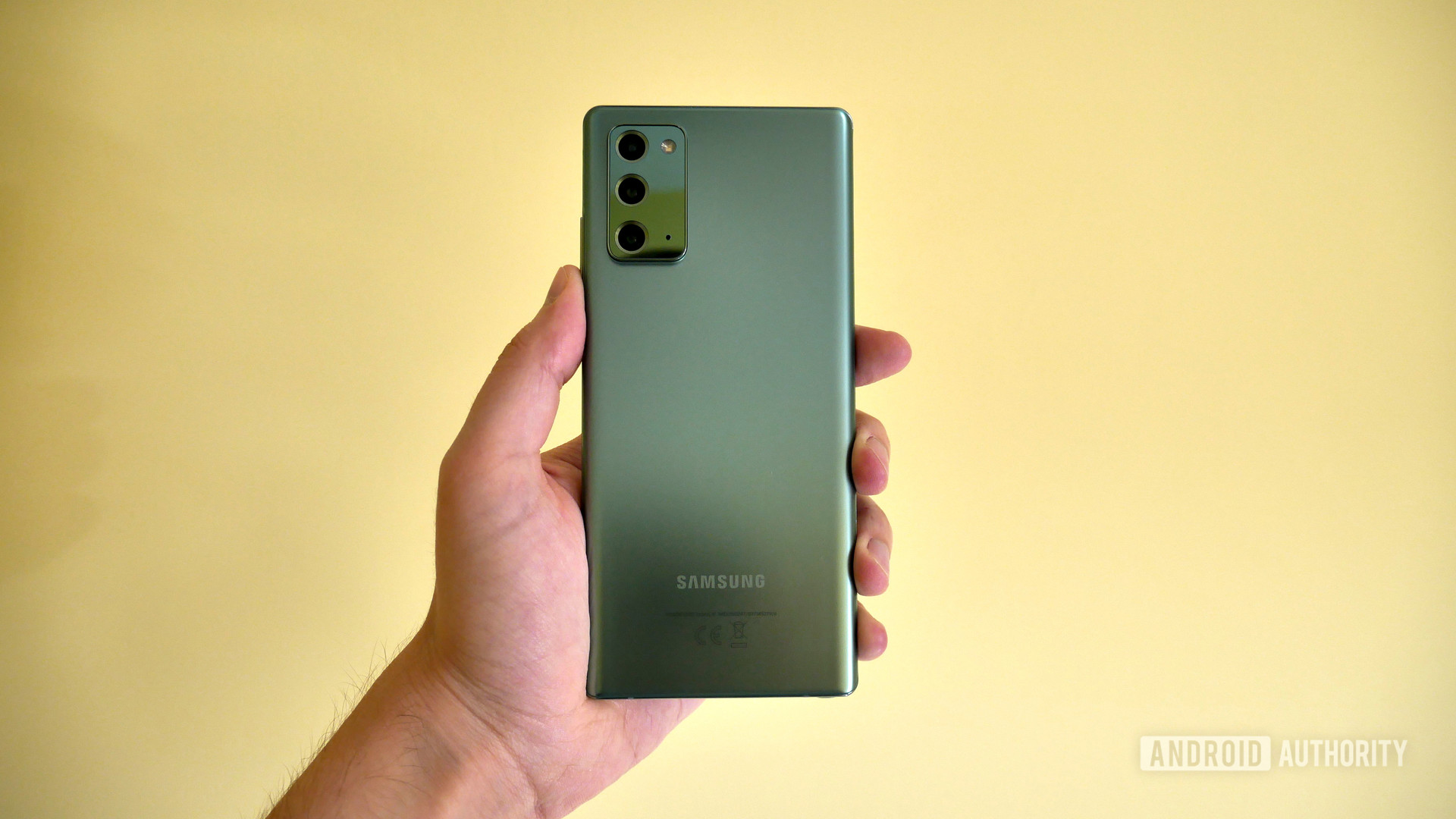
Rather than the ubiquitous glass sandwich build, the Note 20 opts for a rear casing with a brushed-like feel that Samsung calls “glasstic.” We’ve seen this material on a handful of mid-tier Galaxy A series phones. It looks like plastic and it feels like plastic. If you tap it, it sounds like plastic and if you press on it, it compresses like plastic. Why? Because it is plastic.
Samsung can dress it up through fancy marketing, but there’s no way to obfuscate the fact that this is a $1,000 phone that’s almost 50% plastic on the outside. That’s not to say there aren’t some advantages to plastic over glass. Plastic doesn’t attract a smorgasbord of smudges and fingerprint smears. Scratches are more common, but nowhere near as problematic as cracked glass. It also means the Note 20 is fairly light — just 192g compared to the Note 20 Ultra’s 208g.
Samsung's glasstic looks like plastic and feels like plastic... because it is plastic.
The front glass also gets a downgrade from the Gorilla Glass Victus found on the Note 20 Ultra. Instead, the vanilla model uses Gorilla Glass 5 to cover the display. That’s the kind of trade-off some may be prepared to make for a $300 price reduction. But when every other part of the Note 20’s design screams premium and you’re trading blows with other immaculate $1,000 devices, the unsatisfying feeling of plastic on your palm — itself exacerbated by the faux-frosted texture — acts as a constant reminder that Samsung cut a huge corner that’s very hard to justify on a flagship phone.
Sadly, the head-scratching design decisions don’t stop there. Like the Galaxy Note 10 before it, the Galaxy Note 20 doesn’t offer expandable storage. However, what’s more puzzling is a seemingly innocuous change from the Note 10 series. The S Pen and bottom-firing speaker are now on the left side of the base of the phone.
The S Pen placement is fine, the speaker location is not. When playing a game or watching a movie my palm always covered the grille. You can still hear what’s going on because there’s a top speaker in the earpiece, but you can kiss stereo audio goodbye. The speakers themselves offer limited depth and bass, but are clear and can get quite loud without distorting.
The Galaxy Note 20 is by no means a poorly designed phone. In fact, it’s arguably better than the Note 20 Ultra from a pure ergonomics standpoint, as that almighty camera bump isn’t anywhere near as chunky. Yet while the quality standards are broadly excellent, that plastic back represents a trend that defines the Note 20 — not quite premium for a premium price.
Display: Solid, not fluid
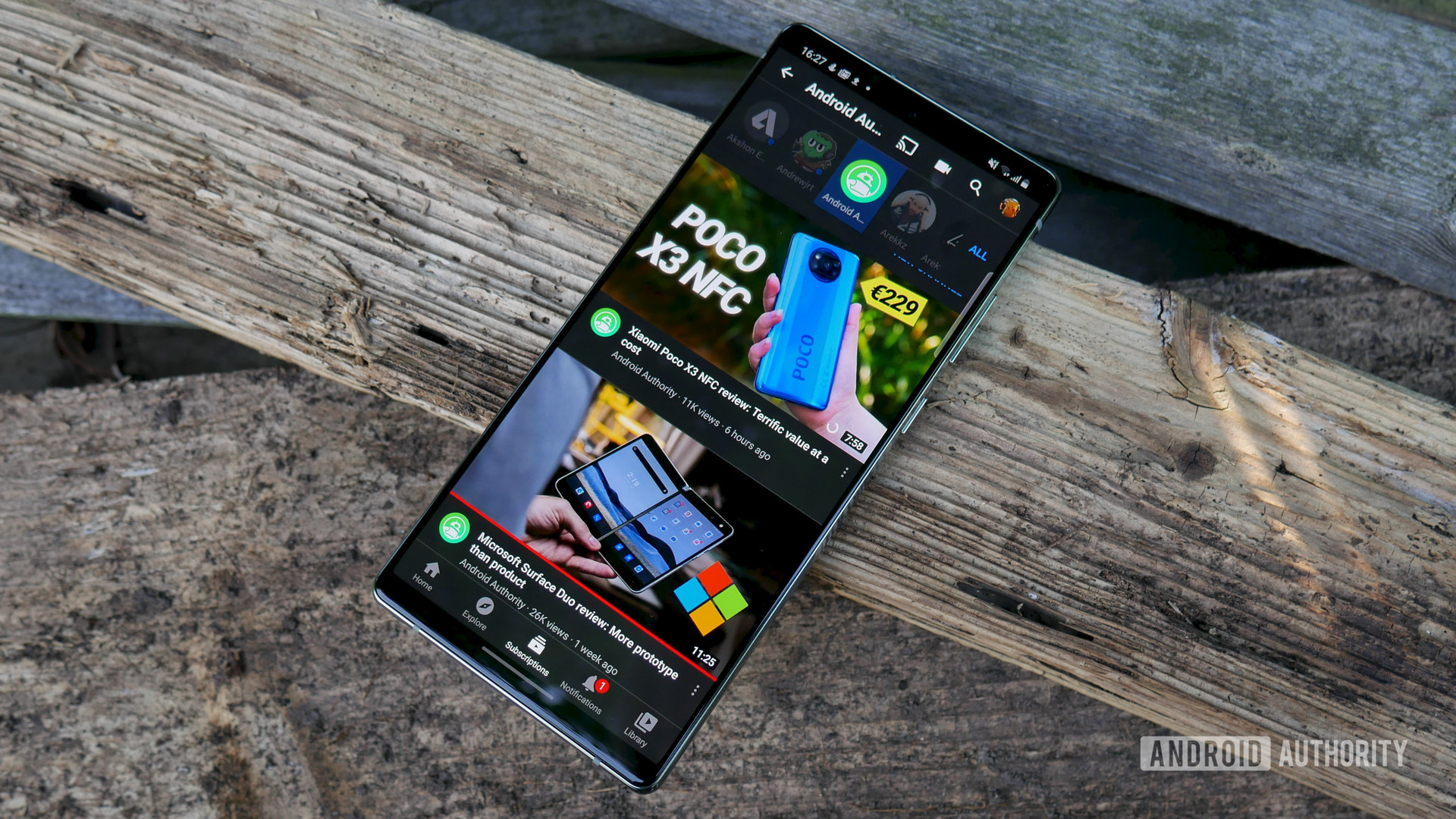
- 6.7-inch Super AMOLED Infinity-O
- Full HD+
- HDR 10+
- 20:9 aspect ratio
Samsung has an incredible pedigree for smartphone displays and that level of quality is maintained for the Galaxy Note 20’s 6.7-inch AMOLED panel. Mostly.
Peak brightness hit a respectable 640 nits in our testing. This tallied with my experience of solid outdoor visibility, but I found it lacking in direct bright sunlight. The display trends towards warmer temperatures and colors pop with that quintessential high contrast look you find in a top-end Samsung phone. There are also options to adjust RGB or the white balance to your liking in addition to a blue filter, adaptive brightness, and plenty more toggles and tweaks in the Settings menu.
The overall caliber is impeccable then, but sadly there are compromises here too. The least impactful concession is the 1080p maximum resolution. It’d be fair to expect Quad HD in this price bracket, but even on a display this size it’s hard to tell the difference unless you actively look for one.
In fact, if you’re really into tech and you’re using a modern Samsung flagship you’ve probably set your phone to 1080p to take advantage of the higher refresh rate — and there’s the rub. The Galaxy Note 20 is a 60Hz panel. For a phone ostensibly designed for power users, this is a shocking omission that makes navigation on the Note 20 feel sluggish. Other Samsung phones ask for a trade-off: lower resolution for a faster refresh rate, up to as much as 120Hz. The Note 20 is the worst of both worlds.
Samsung set its own bar for high refresh rate displays and the Note 20 falls way under it.
This is especially frustrating as the Note 20’s display has a few points in its favor over the Note 20 Ultra. The screen is flat, which should delight curved display haters. I didn’t experience any accidental touches and the phone retains features like the handy Edge Panel despite the lack of curvature. Plus, what bezels there are remain razor-thin, though the punch-hole cutout is oddly a little larger on the Note 20 compared to the Note 20 Ultra. Otherwise, the front-facing camera is identical, so I’m not sure what the reason is for this.
There’s also an in-display fingerprint reader of the ultrasonic variety. It’s quite slow, taking 1-2 seconds to register my fingerprint, though generally this comes at the benefit of greater accuracy compared to an optical reader. I definitely found this to be the case. The Note 20 almost always unlocked first time.
Overall, the Note 20 has a big and beautiful screen that is only undermined by its refresh rate. 60Hz/Full HD on a modern flagship phone? That’s poor form.
Performance: Lukewarm
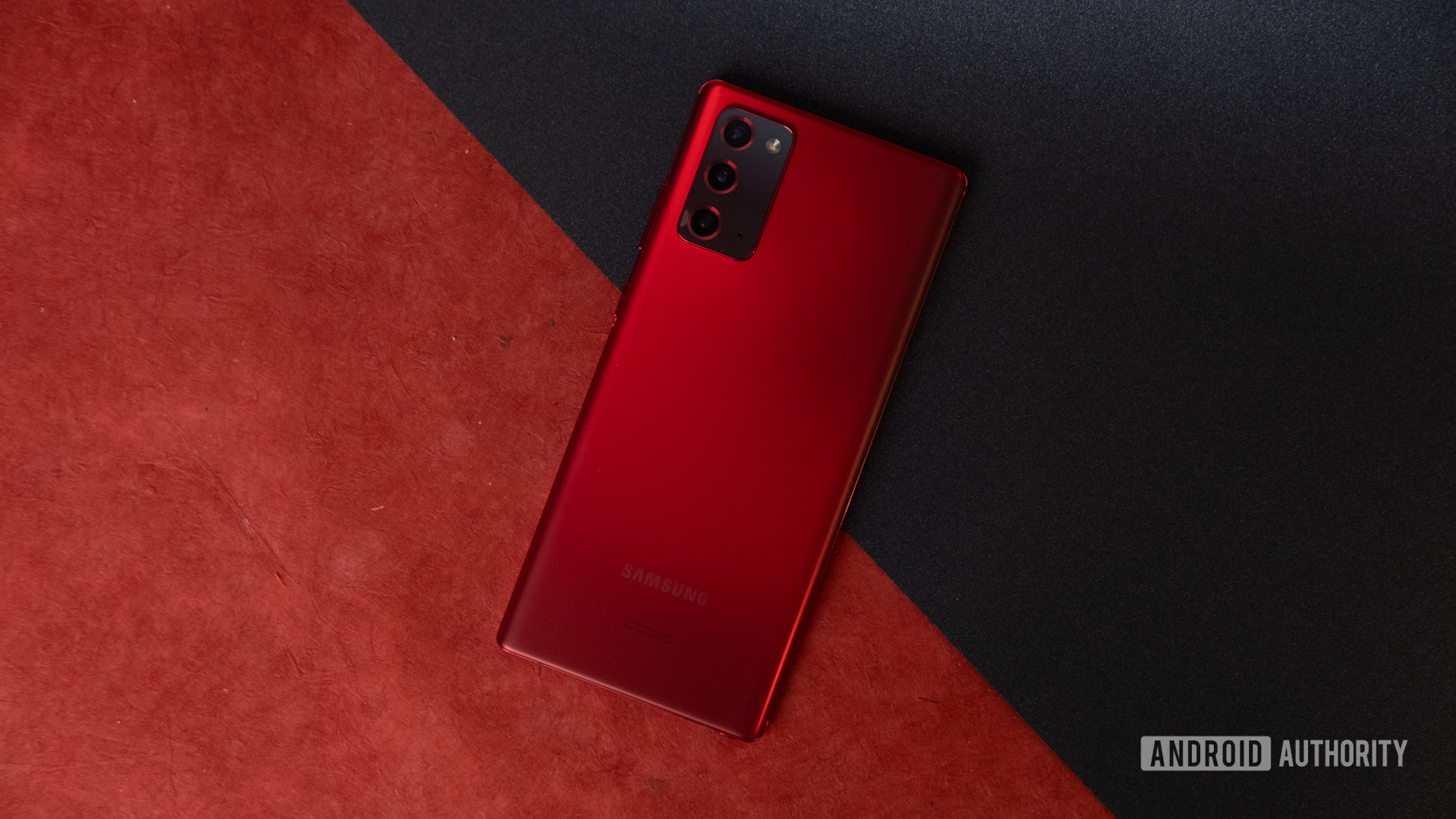
- Samsung Exynos 990
- Mali-G77 MP11 GPU
- 8GB RAM
- 128/256GB storage
Folks buying the Galaxy Note 20 over in the US get their hands on the model powered by Qualcomm’s 2020 flagship silicon — the gaming-optimized Snapdragon 865 Plus with its 3HGz-barrier-breaking prime core. In Europe and Asia, however, the entire Galaxy Note 20 series features Samsung’s own Exynos 990 chipset. This is the same processor that powered the Galaxy S20 family outside of North America.
Based on raw specs alone the divide between Snapdragon and Exynos should be getting much worse, but the benchmarks tell a slightly different story.
Based on an average across multiple runs, the Exynos Galaxy Note 20 completed our Speed Test G test in one minute and 52 seconds. Unsurprisingly this comes out slower than the Snapdragon Note 20 Ultra tests we performed which averaged out at one minute and 32 seconds in 60Hz mode and one minute and 34 seconds in 120Hz mode.
The good news is that Samsung has clearly made some tweaks behind the scenes following the backlash over the performance disparity between the two Galaxy S20 models. Instead of a 30-second gap in Speed Test G scores between Galaxy S20 variants, the Exynos Note 20 managed to cut that time to 20 seconds. That’s small progress but progress all the same.
Performance in the standard array of benchmarks was also respectable but not world-beating. The most notable result is the 3DMark score which exposes the weakness of the Exynos 990’s Mali GPU compared to Qualcomm’s superior Adreno GPUs.
This all tallies with real-world use. While the Exynos Note 20 is technically underpowered, it never exhibited any lag or slowed down when I was zipping around menus or multitasking. Navigating around the phone can feel slow due to the 60Hz refresh rate, but the CPU proved to be a perfectly capable performer. It also ran every Android game I could think of, though it struggled to hit consistent frame rates when emulating GameCube games in Dolphin.
Read more: Samsung Exynos processor guide
The bigger worry was heat. The Galaxy Note 20 gets hot very quickly, especially when playing games. It never became too hot to the point where you couldn’t hold the phone, but it wasn’t comfortable either. This echoed our experience with the Snapdragon Note 20 Ultra, so it’s not an Exynos issue. There’s already been some confusion over Samsung’s different cooling systems, but the heat concerns across two variants suggest there’s more to the story.
Elsewhere, the Note 20 comes with 8GB of RAM as standard and 256GB of UFS 3.0 storage. This is actually one area where the Exynos version wins out in the specs race, as the base Snapdragon Note 20 model only has 128GB storage. The lack of a microSD card slot will really sting for those buying the latter.
Battery life: Acceptable
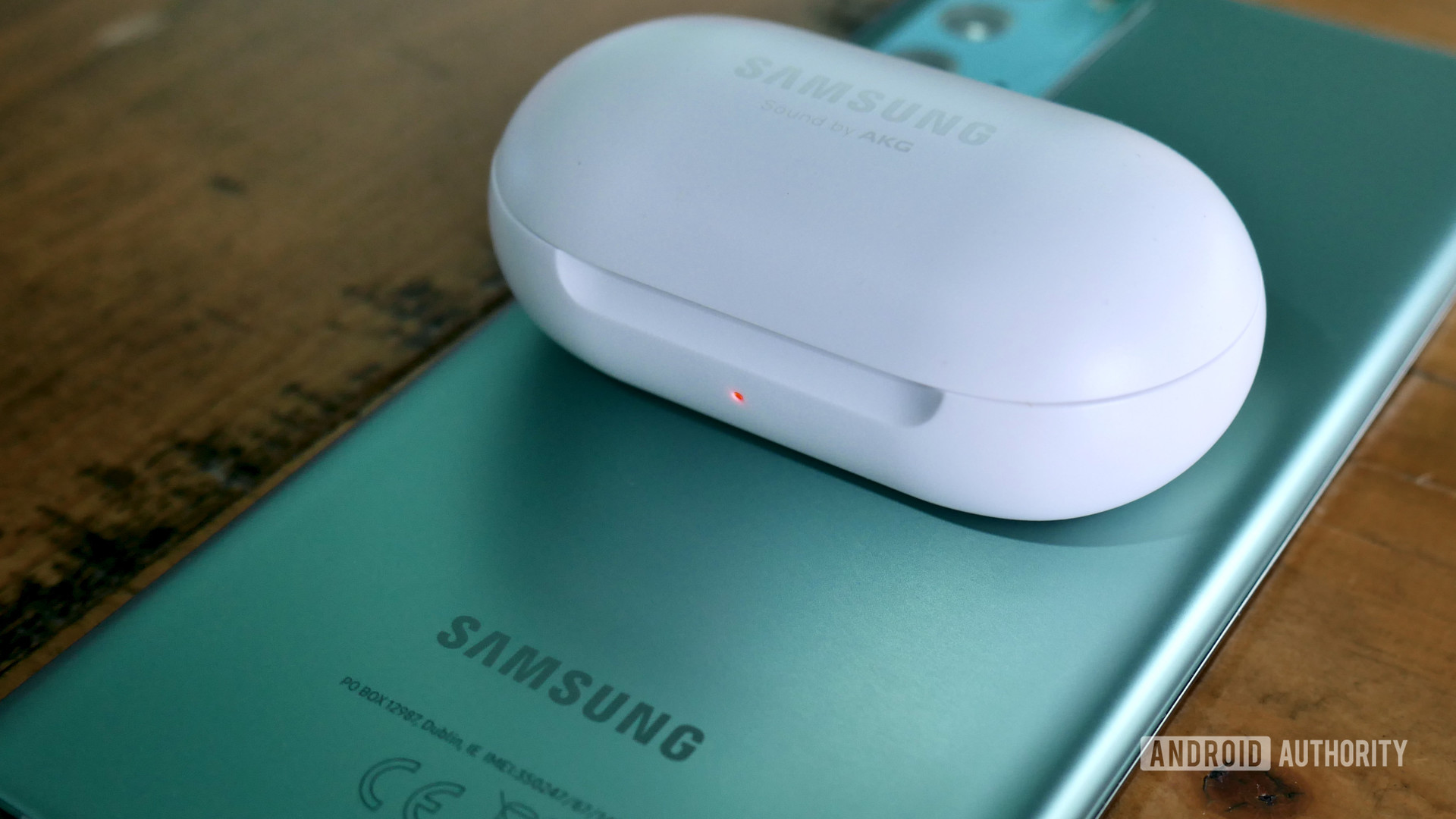
- 4,300mAh battery
- 25W wired USB Power Delivery
- 15W wireless charging
- 4.5W reverse charging
There was a time when the Note series was renowned for industry-leading battery life. Those days are long gone.
In my time with the Galaxy Note 20, I was regularly hitting the end of the day with ~25% left in the tank and an average of 6-7 hours screen on time. This was based on relatively standard usage. Some Twitter here, a quick ten-minute PUBG Mobile game there, plus checking emails, Slack, and other daily tasks for work and play. I’d call the results solid, but unspectacular.
Under stress, the Galaxy Note 20 begins to falter. Our Rocky test, which repeatedly runs Speed Test G until on a loop, managed to take the phone from a full charge to zero in three hours and 22 minutes. This is well below the top battery performers and it’d be fair to expect more from a phone with a 60Hz, 1080p display, and a reasonably-sized 4,300mAh cell.
The Note 20's battery life is solid, but unspectacular.
Power management on Exynos SoCs is notorious for being sub-par, so this may explain the average results considering the specs. On a positive note, there are plenty of power management options available, including Samsung’s own adaptive power-saving mode in addition to Android 10’s app management feature.
As for charging the phone, the Galaxy Note 20 averaged out at ~70 minutes to hit maximum charge from flat when using the 25W USB Power Delivery brick that ships with the phone. It also supports 15W wireless charging and Samsung’s 4.5W Wireless PowerShare technology for reverse charging accessories. These aren’t the fastest speeds in the market by any means, but it at least offers parity with the Note 20 Ultra.
Camera: Notably good

- 12MP OIS wide-angle Dual Pixel PDAF (ƒ/1.8, 1.8μm)
- 64MP OIS telephoto PDAF (ƒ/2.0, 0.8μm, hybrid optical 3x zoom)
- 12MP ultra-wide (ƒ/2.2, 1.4μm, 120 degree FOV)
- Front: 10MP Dual Pixel PDAF (ƒ/2.2, 1.22μm)
- Video: 8K at 24fps in 16:9, 4K at 60fps
Samsung typically reserves its best camera tech for the Galaxy S series and that remains true for the Galaxy Note 20. Nevertheless, the Note 20 is no slouch in the photography stakes and, in the right conditions, can deliver spectacular results.
The Galaxy Note 20 features a triple camera on the rear with a 12MP main sensor, a 12MP ultra-wide camera, and a 64MP telephoto camera that supports up to 3x hybrid optical zoom. If you’re familiar with the Note 20 Ultra then the drop from Samsung’s top-tier 108MP primary shooter to a modest 12MP camera will be the big takeaway.
In daylight, the Galaxy Note 20 produces the kind of crunchy, contrast-heavy images Samsung phone cameras are known for. Do you like your snaps to look Instagram-ready? Then you’ll love the saturated look of images taken with the Note 20’s main camera. This works especially well outdoors where blue skies and green fields threaten to burst out of the frame.
The auto HDR does a lot of heavy lifting in landscape scenes, white balance is fairly consistent throughout, and the dynamic range is solid, though detail falls off a little if you crop in. The Note 20 lacks the laser autofocus found on the Note 20 Ultra, but the Dual Pixel phase detection does the job just fine.
The praise continues for low light performance. The dedicated Night mode takes a while to process images but is capable of transforming dimly lit shots into almost daylight-like photos. The shots of the cat statue above were taken at 8PM as the evening drew in with light coming from a nearby window. Even the regular shooting mode retains plenty of detail and manages to keep noise to a minimum.
The telephoto lens may be underwhelming if you’ve been reading the marketing for the ridiculous 50x/100x Space Zoom of Samsung’s recent Ultra phones. Technically, the Note 20 can reach up to 30x digital, though images turned to pure mush at anything beyond 10x zoom. For truly usable results, the 3x hybrid optical mode is perfectly fine.

The ultra-wide camera mirrors the main shooter very well. While there is a loss in detail, you still get the same overly-saturated, dynamic results, only this time with a much wider 120-degree field-of-view. I really enjoyed using the Note 20’s ultra-wide sensor.
The 10MP selfie camera dials down the contrast and has some clear smoothing going on in post-processing, but generally, the quality is decent. Portrait mode — or Live Focus, as Samsung calls it — zooms in slightly for both selfies and regular shots, though you can change that with a quick tap. Edge detection was good-to-great in all cases and there are plenty of additional filters and effects for selfie-holics.
As for the camera app, Samsung strikes a reasonable balance between ease-of-use and offering a variety of modes to keep your photography experience fresh. The Pro mode is there for tinkerers and there’s an AR Zone for those that want to decorate shots with emojis and the like. My only gripe is the prime spot for Single Take in the carousel. The gimmicky mode captures 10 seconds of video and produces various different images and clips. It’s fun, but not particularly useful. It really should’ve been replaced with Night mode in the core camera UI.
Samsung’s big draw for video is 8K (or so the endless YouTube ads have told me) which you can capture at 24fps in the 16:9 aspect ratio. You’ll probably want to stick to 4K at 60fps unless you want to annihilate your storage, or 4K 30fps to take advantage of the reliable tracking autofocus. Video captured on the Note 20 looks very crisp.
Overall, the Samsung Galaxy Note 20 camera delivers the goods. It might not boast the mouth-watering specs of Samsung’s Ultra devices, but it proves yet again that numbers aren’t everything for mobile photography. You can check out full resolution sample images in a Drive folder here.
Software: One of a kind
- Android 10, update to Android 12 coming soon
- One UI 2.5, update to One UI 4 beta available
- Three years of updates/patches
The Galaxy Note 20 launched with Android 10 out of the box and Samsung’s custom One UI skin on top. The latter is instantly recognizable and among the more unique skins available.
Like the Note itself, everything is big, bold, and quintessentially Samsung. App icons are huge by default, while the notification bar and quick settings engulf the screen. The Settings menu isn’t afraid to fill the display with white space (or black space if you have dark theme on) either. This is intended to make one-handed use easier and works really well for the Galaxy S series. I wasn’t quite as taken with this approach for the Note 20. This is a phablet with a built-in stylus. It’s meant to be used two-handed! It would’ve been nice to see some specific tweaks to the UI specifically for the Note’s many use cases.
Samsung is also fairly heavy-handed in pushing its own ecosystem with its own apps and services. If that’s not your thing, you can replace almost all of this with Google apps if you wish. Extra features like the swipe-up Samsung Pay card and the Samsung Daily feed can also be deactivated. That’s not true for Bixby, but Samsung’s oft-maligned assistant keeps to itself these days unless you go out of your way to use it. Plus, Bixby Routines are actually kind of useful. Give Bixby some love, it needs it.
Read more: Here’s everything new in Samsung One UI 4.0
Samsung’s growing relationship with Microsoft is also evident when using the Note 20, though once again you’re not forced into anything. This manifests as a Link to Windows option in the Settings and is basically the Your Phone app but directly integrated into the device. If activated, the feature lets you share SMS messages and photos with a PC or laptop and see notifications on your desktop. You can also mirror your entire phone screen so long as you’re on the same Wi-Fi connection on both devices. While it’s nowhere near on the same level of integration as Continuity for iPhones and Macs, it’s a neat optional bonus for Windows users.
Not a Windows user but still want a PC experience? You’re in luck because DeX is back and this time it’s gone wireless… sort of. The desktop-style interface is now compatible with TVs that support Android screen mirroring. If that sounds like vague criteria, that’s because it is. Samsung recommends a 2019 or later Samsung TV (because of course it does) and sadly I don’t have one of those to test it out. It still works just fine via USB-C-to-HDMI on PCs/Macs if you have a suitable cable though.
So far, Samsung has brought Android 11 and the One UI 3.1 skin to its Galaxy Note 20, with further updates on the way. The One UI 4 beta was recently launched, which means that you can test out some of the new customization features on your phablet already. A stable launch is expected in January 2022.
Before we move on from software, it’d be remiss of me to not mention Samsung’s welcome promise of three years of Android upgrades and four years of security patches. That means the Note 20 should be supported all the way through to Android 13 and a further year for security updates. Good stuff, Samsung.
S Pen: Bonus points
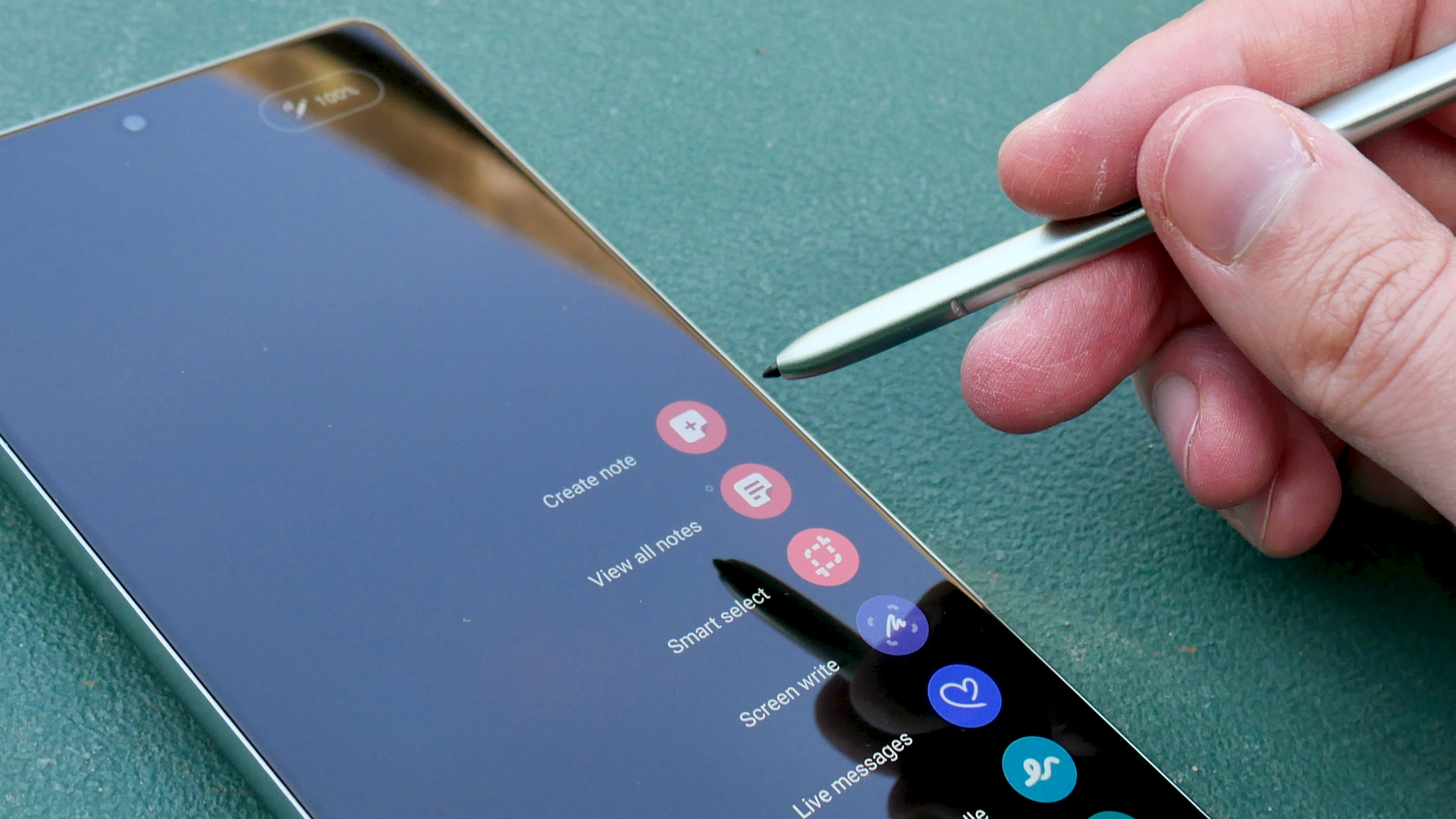
- 105.08 x 5.8 x 4.35mm
- 3.04g
- Bluetooth enabled
- 26ms latency
You can’t talk about a Galaxy Note phone and not discuss the S Pen. The Note series’ iconic stylus doesn’t get as much love for the Note 20 compared to its Ultra compatriot. Instead of the latter’s frankly crazy 9ms of latency, the vanilla Note 20 is rated at 26ms. That’s still barely shy of the Apple Pencil and Surface Pen and a big improvement over the Note 10 series’ 45ms. In practice, the S Pen felt extremely responsive.
The S Pen feature set has also been expanded. There are new Air Actions for taking screenshots, launching the camera, and generally navigating around the phone. I used them once to test them out and promptly forgot all the commands.
Samsung Notes received some love too. I especially liked the new folder paths as you can now organize your scribbles into sub-folders rather than dump them all in one place. You can also sync them across other Samsung devices.
In brief, the S Pen is better than ever and still the Note’s defining feature.
Galaxy Note 20 specs
| Samsung Galaxy Note 20 | Samsung Galaxy Note 20 Ultra | |
|---|---|---|
Display | Samsung Galaxy Note 20 6.7-inch AMOLED Infinity-O FHD+ resolution 20:9 aspect ratio 60Hz refresh rate | Samsung Galaxy Note 20 Ultra 6.9-inch AMOLED Infinity-O WQHD+ resolution 19.3:9 aspect ratio 120Hz refresh rate |
Construction | Samsung Galaxy Note 20 Plastic (aka Glasstic) body Flat display Gorilla Glass 5 display cover | Samsung Galaxy Note 20 Ultra Metal and glass body Curved (Edge) display Gorilla Glass 7 display cover |
CPU | Samsung Galaxy Note 20 NA: Qualcomm Snapdragon 865 Plus Global: Samsung Exynos 990 | Samsung Galaxy Note 20 Ultra NA: Qualcomm Snapdragon 865 Plus Global: Samsung Exynos 990 |
Storage | Samsung Galaxy Note 20 NA: 128GB internal No microSD card support Global: 256GB internal No microSD card support | Samsung Galaxy Note 20 Ultra NA: 128GB or 512GB internal microSD card support up to 2TB Global: 256GB or 512GB internal microSD card support up to 2TB |
RAM | Samsung Galaxy Note 20 8GB LPDDR5 | Samsung Galaxy Note 20 Ultra 12GB LPDDR5 |
Power | Samsung Galaxy Note 20 4,300mAh battery 25W wired charging 15W wireless charging 4.5W reverse wireless charging | Samsung Galaxy Note 20 Ultra 4,500mAh battery 25W wired charging 15W wireless charging 4.5W reverse wireless charging |
Cameras | Samsung Galaxy Note 20 Rear: 12MP 2PD OIS wide-angle (ƒ/1.8, 1.8μm) 64MP telephoto (ƒ/2.0, 0.8μm, hybrid 3x zoom) 12MP ultra-wide (ƒ/2.2, 1.4μm) Front: 10MP 2PD AF (ƒ/2.2, 1.22μm) | Samsung Galaxy Note 20 Ultra Rear: 108MP PD OIS wide-angle (ƒ/1.8, 0.8μm) 12MP telephoto (ƒ/3.0, 1.0μm, optical 5x zoom) 12MP ultra-wide (ƒ/2.2, 1.4μm) Laser AF Front: 10MP 2PD AF (ƒ/2.2, 1.22μm) |
Video | Samsung Galaxy Note 20 8K at 24fps in 16x9 or 21:9 | Samsung Galaxy Note 20 Ultra 8K at 24fps in 16x9 or 21:9 |
Security | Samsung Galaxy Note 20 In-display fingerprint sensor Ultrasonic technology | Samsung Galaxy Note 20 Ultra In-display fingerprint sensor Ultrasonic technology |
Durability | Samsung Galaxy Note 20 IP68 certified | Samsung Galaxy Note 20 Ultra IP68 certified |
Connectivity | Samsung Galaxy Note 20 5G (separate sub-6GHz and mmWave models) Wi-Fi 6 4G only model available in selected markets | Samsung Galaxy Note 20 Ultra 5G (sub-6GHz and mmWave) Wi-Fi 6 |
Colors | Samsung Galaxy Note 20 Mystic Gray Mystic Green Mystic Bronze | Samsung Galaxy Note 20 Ultra Mystic Black Mystic White Mystic Bronze |
Dimensions & weight | Samsung Galaxy Note 20 75.2 x 161.6 x 8.3mm 192g (sub-6GHz only) 194g (mmWave supported) | Samsung Galaxy Note 20 Ultra 77.2 x 164.8 x 8.1mm 208g |
Value and competition
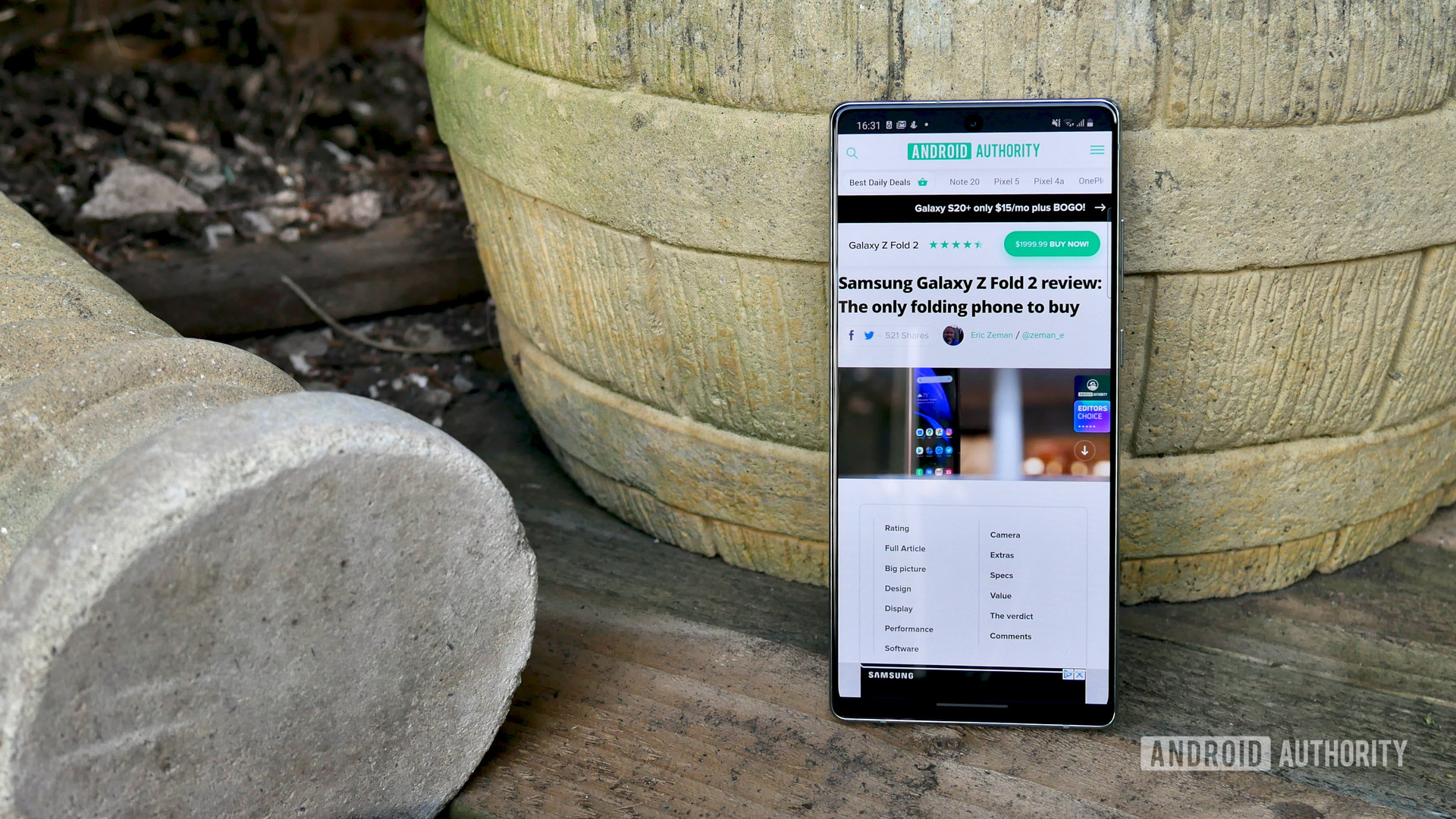
- Samsung Galaxy Note 20 (4G only, Exynos): 8GB/256GB — £849/€959
- Samsung Galaxy Note 20 5G (Snapdragon): 8GB/128GB — $999
- Samsung Galaxy Note 20 5G (Exynos): 8GB/256GB — £949/€1,059
Let’s not sugarcoat things: the Galaxy Note 20 was overpriced at launch.
The Galaxy Note 20 5G started at $999 in the US, £949 in the UK, and €1,059 across Europe. Considering all of the downgrades from the Galaxy Note 20 Ultra and the laundry list of absent flagship-tier features, those prices remain extremely hard to stomach.
The model I tested was the 4G-only model, which is only available in select markets, not including North America. This variant went for £849/€959, which is slightly more palatable if you’re not interested in future-proofing your phone with 5G data speeds. I’m not sure you should have to force yourself to make that additional compromise, but it’s there for those that can buy it.
Now, the Note 20 has had the benefit of a pretty solid price cut wherever you can still find it on sale. It’s dropped by about $300, down to $699. This puts it in line with more affordable flagships like the Samsung Galaxy S21 or the Google Pixel 6 in terms of cost. While the Note 20 is working with slightly older hardware, Samsung’s update policy makes it a relevant option for the future, especially if you really want S Pen functionality on the cheap.
However, Samsung’s Galaxy S21 series is better than ever. All three devices have dropped in price significantly and the Galaxy S21 Ultra now supports the S Pen (albeit without a dock — you need a case for that).
Look further afield and the competition gets even hotter. The OnePlus 9 Pro is a true killer flagship with the latest internals and a Hasselblad-tuned camera, though it now has a price tag to match. Big phone fans may also be tempted by the LG V60, another Note 20 rival on a budget.
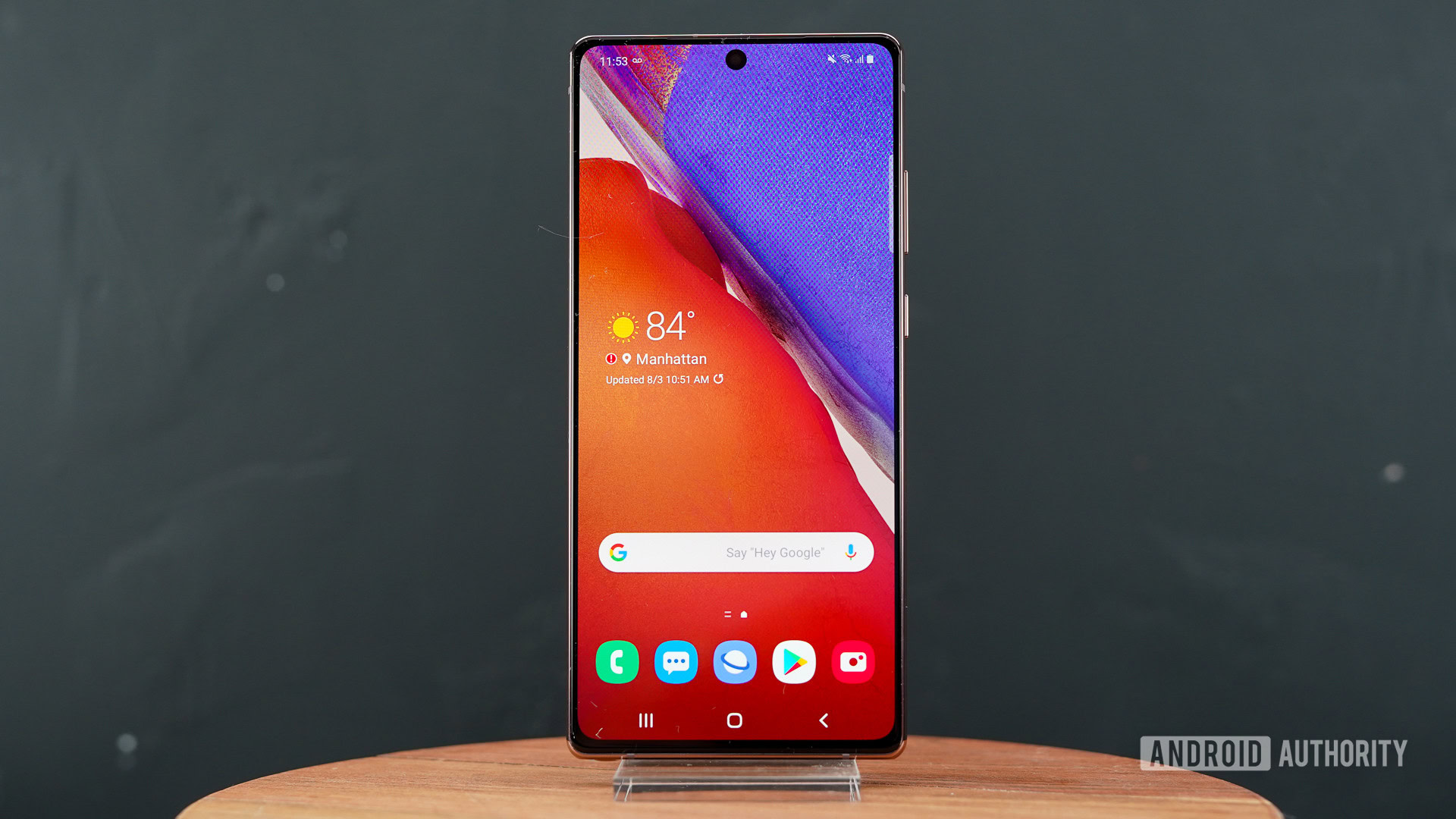
Samsung Galaxy Note 20 review: Should you buy it?

The Galaxy Note 20 is not a bad phone. Samsung doesn’t make those, especially in the flagship space. But it does lack almost all of the wow factor features you might expect from a modern premium phone.
Taking the inexplicably high launch price aside, the Galaxy Note 20 is an exercise in playing things safe to a fault. Perhaps imagined as the low-key counterpart to the Note 20 Ultra — a phone we already deemed to be a little uninspiring. Instead, you’re just left wondering what on Earth happened during the decision-making process to result in such an underbaked final product.
See also: Best Samsung phones you can buy
The glass sandwich blueprint of smartphone design is well overdue a rethink, but the solution isn’t swapping out glass for plastic. Samsung itself has set the industry baseline for high refresh rate displays with the S20 series, yet the Note 20 is locked at 60Hz in 1080p.
Things get even worse for buyers outside of North America. The Exynos SoC is competent, but you’re still getting an inferior version of an already sub-par value proposition.
As the biggest smartphone marker in the world, it’s really no surprise that Samsung releases a ton of phones each year. But the sheer number of premium phones on offer from the South Korean giant in 2020 hit a breaking point. It was no surprise to see it skip 2021, and the line’s future seems uncertain now the Galaxy Z Fold series is taking prime position as Samsung’s secondary device behind the Galaxy S.
The Galaxy Note 20 is overpriced and underbaked, but the recent price drop brings it to a better temperature.
Sadly, the last two entities in the vanilla, non-Plus/Ultra Note line have muddied the legacy of the Note name beyond recognition. If the Galaxy Note 20 does prove to be the last of its name, Samsung will only have had itself to blame.
That’s it for our Samsung Galaxy Note 20 review. What do you make of the standard Note 20 device? Let us know in the comments.